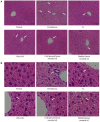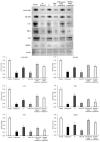Effects of Cold-Pressing and Hydrodistillation on the Active Non-volatile Components in Lemon Essential Oil and the Effects of the Resulting Oils on Aging-Related Oxidative Stress in Mice
- PMID: 34195220
- PMCID: PMC8236505
- DOI: 10.3389/fnut.2021.689094
Effects of Cold-Pressing and Hydrodistillation on the Active Non-volatile Components in Lemon Essential Oil and the Effects of the Resulting Oils on Aging-Related Oxidative Stress in Mice
Abstract
The aim of this study was to analyze the non-volatile composition and antioxidant differences of lemon essential oils (LEOs) obtained by cold-pressing vs. hydrodistillation. Pathological observations showed that LEO effectively inhibited liver injury caused by oxidative stress, and CPLEO was more effective than HDLEO. CPLEO increased serum T-AOC, SOD, GSH, and GSH-Px levels while decreasing NO, COX-2, IL-6, IL-1β, IFN-γ, and TNF-α levels in mice with oxidative damage. The effects of CPLEO were stronger than those of HDLEO and similar to those of vitamin C. CPLEO upregulated mRNA and protein expressions of Cu/Zn-SOD, Mn-SOD, CAT, HO-1, Nrf2, and NQO1 while downregulating nNOS, iNOS, IL-1β, COX-2, TNF-α, and NF-κB mRNA expression and nNOS, eNOS, iNOS, and COX-2 protein expression in mice with oxidative damage. The results demonstrate that LEO has good antioxidant effects and that CPLEO has a better antioxidant effect than HDLEO as it retains more active non-volatile substances.
Keywords: antioxidant; cold-expression; coumarins; furocoumarins; oxidative stress.
Copyright © 2021 Li, Xiang, Pan, Long, Cheng, Han and Zhao.
Conflict of interest statement
The authors declare that the research was conducted in the absence of any commercial or financial relationships that could be construed as a potential conflict of interest.
Figures








References
LinkOut - more resources
Full Text Sources
Research Materials
Miscellaneous

